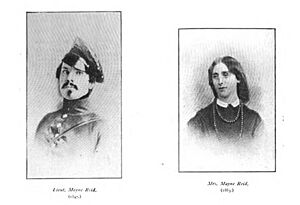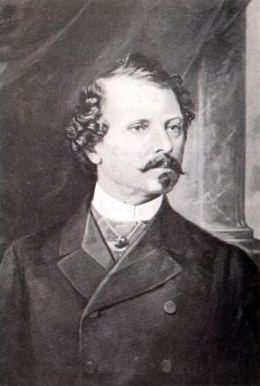Thomas Mayne Reid facts for kids
Quick facts for kids
Thomas Mayne Reid
|
|
|---|---|

Thomas Mayne Reid, c. 1850
|
|
| Born | 4 April 1818 Ballyroney, County Down, Ireland |
| Died | 22 October 1883 (aged 65) London, England |
| Occupation | Novelist |
| Genre | Adventure |
| Signature | |
 |
|
Thomas Mayne Reid (born April 4, 1818 – died October 22, 1883) was a famous writer from Ireland. He wrote many exciting adventure books. He even fought in the American-Mexican War from 1846 to 1848.
Reid's books often described life in America. He wrote about the lives of Native Americans and the challenges of slavery. His adventure stories were similar to those by other well-known authors like Frederick Marryat. He also admired the poet Lord Byron. The adventures in his novels often took place in the American West, Mexico, South Africa, the Himalayas, and Jamaica.
Contents
About Thomas Mayne Reid
His Early Life
Thomas Mayne Reid was born in a small village called Ballyroney. This village is in County Down, which is now part of Northern Ireland. His father was a minister.
His father wanted him to become a minister too. In 1834, Thomas started studying at a school in Belfast. He stayed there for four years but didn't finish his studies. After that, he went back home and worked as a teacher.
In 1839, Reid sailed to New Orleans, Louisiana. He arrived there in January 1840. He quickly found a job working as a clerk. After six months, he left his job because he didn't agree with slavery. Later, he used Louisiana as the setting for one of his books, an anti-slavery novel called The Quadroon.
Reid then traveled to Tennessee. He tutored children on a plantation near Nashville. Years later, he used this area for his novel The Wild Huntress. He also started his own school in Nashville, but it didn't last long. In 1841, he worked as a clerk again.
His Writing Career
In 1842, Reid moved to Pittsburgh, Pennsylvania. This is where he started his writing career. He wrote stories and poems for a local newspaper, using the pen-name "The Poor Scholar."
In 1843, Reid moved to Philadelphia. He worked as a journalist for three years. He also had his poems published in popular magazines. While in Philadelphia, he met the famous writer Edgar Allan Poe. Poe once described Reid as a great storyteller.
When the Mexican–American War started in 1846, Reid was working as a reporter. He joined the army as a second lieutenant in November 1846. In January 1847, he sailed with his regiment to Mexico.
Reid was a correspondent for a New York newspaper during the war. He wrote articles about his experiences. In September, during the Battle of Chapultepec, he was badly wounded in his leg. He was promoted to first lieutenant for his bravery. In May 1848, he left the army and returned to New York.
Reid's first play, Love's Martyr, was performed in Philadelphia in October 1848. In 1849, he published War Life, which was about his time in the army.
He then moved to London, England. In 1850, he published his first novel, The Rifle Rangers. Many more successful books followed, including The Scalp Hunters (1851) and The Desert Home (1852).
In 1853, he published The Boy Hunters. This book was set in Texas and Louisiana. It was a favorite of young Theodore Roosevelt, who later became a U.S. President. That same year, Reid married Elizabeth Hyde. She was 15 years old and the daughter of his publisher.
Reid continued to write novels based on his adventures in America. Some of his other popular books include The White Chief (1855), The Quadroon (1856), Osceola (1858), and The Headless Horseman (1865).
He spent a lot of money, even building a large house in England that looked like a Mexican ranch. This led to him going bankrupt in 1866. In 1867, he moved back to New York, hoping to find success again. He started a magazine called Onward Magazine.
His Later Years
Reid gave lectures in New York and published another novel, The Helpless Hand, in 1868. However, his old war wound started to cause him problems. He was in the hospital for several months in 1870.
His wife did not like living in America. After he left the hospital, they returned to England in October 1870. They lived in Ross on Wye.
Reid then became very sad and was hospitalized again. He tried to write, but he didn't finish much. He mostly lived on his U.S. Army pension, which was not enough. Thomas Mayne Reid died in London at the age of 65. He was buried in Kensal Green Cemetery. His tombstone has a quote from his book The Scalp Hunters: "This is 'weed prairie'; it is misnamed: It is the Garden of God."
His Impact and Books
Thomas Mayne Reid's books, like Young Voyagers, were very popular, especially with boys. His stories about the American West were loved by children across Europe and Russia. Many of his books were translated into Polish and Russian.
Famous people like Vladimir Nabokov remembered The Headless Horseman as a favorite adventure novel from his childhood. He said it gave him a picture of the wide-open prairies. Czeslaw Milosz, a Polish writer, also remembered reading Reid's books in Russian. Even the famous Russian writer Anton Chekhov mentioned "Mayne Reid" in one of his books.
United States President Theodore Roosevelt said that Reid's books were a big inspiration for him when he was young. Roosevelt, who was shy and had asthma, grew up to be an adventurer and studied animals. Russell Miller, who wrote about Arthur Conan Doyle (the creator of Sherlock Holmes), said that Reid was one of Conan Doyle's favorite childhood authors and greatly influenced his writing.
Although Reid often called himself "Captain," official records show he was a lieutenant in the U.S. Army.
Thomas Mayne Reid wrote about 75 novels, along with many short stories. Here are some of his well-known works:
- The Rifle Rangers; or, Adventures in Southern Mexico (1850)
- The Scalp Hunters: A Romance of the Plain (1851)
- The Desert Home: The Adventures of a Lost Family in the Wilderness (1851)
- The Boy Hunters, or, Adventures in Search of a White Buffalo (1853)
- The White Chief; A Legend of North Mexico (1855)
- The Quadroon: or, A Lover's Adventures in Louisiana (1856)
- Osceola the Seminole, or, The Red Fawn of the Flower Land (1858)
- The Headless Horseman (1866)
- Afloat in The Forest; or A Voyage Among the Tree-Tops (1867)
- The Boy Slaves (1865)
- The Castaways: A Story of Adventure in the Wilds of Borneo (1870)
- The Death Shot; or, Tracked to Death (1873)
- The Flag of Distress, or A Story of the South Sea (1876)
- The Man-Eaters (1878)
- Gaspar, the Gaucho, or, Lost on the Pampas: A Tale of the Gran Chaco (1883)
- The Land of Fire: A Tale of Adventure (1885)
Images for kids
Resources
- Thomas Mayne Reid from the Handbook of Texas Online
Sources
See also
 In Spanish: Thomas Mayne-Reid para niños
In Spanish: Thomas Mayne-Reid para niños






